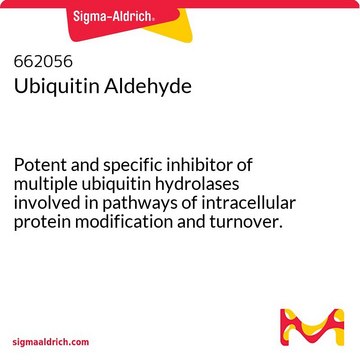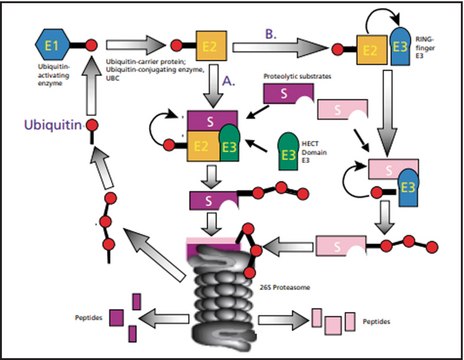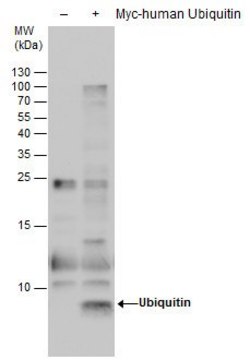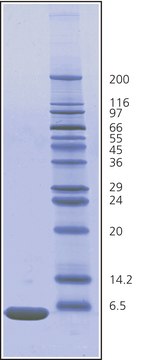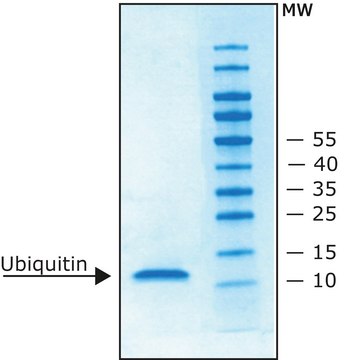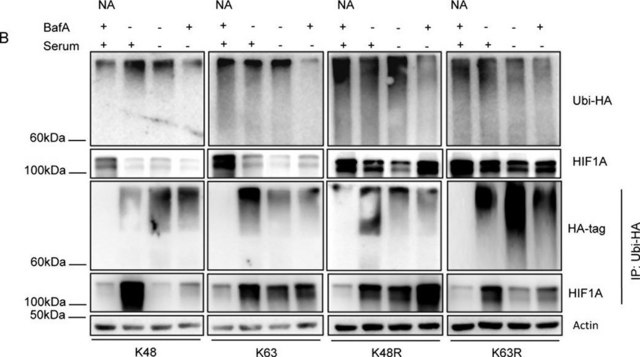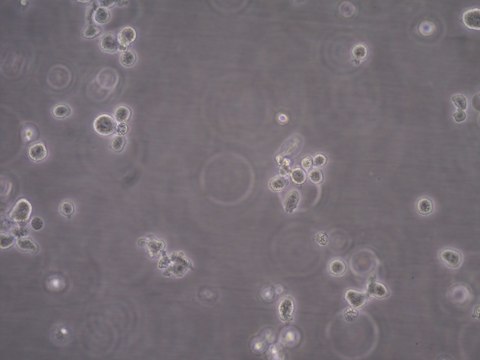SRP6024
Ubiquitin Aldehyde human
recombinant, expressed in E. coli, ≥95% (HPLC)
Sign Into View Organizational & Contract Pricing
All Photos(1)
About This Item
UNSPSC Code:
12352200
NACRES:
NA.32
Recommended Products
biological source
human
recombinant
expressed in E. coli
Assay
≥95% (HPLC)
form
liquid
mol wt
8.5 kDa
packaging
pkg of 50 μg
technique(s)
protein purification: suitable
impurities
Endotoxin, tested
NCBI accession no.
UniProt accession no.
shipped in
dry ice
storage temp.
−70°C
Gene Information
human ... UBA2(7311)
General description
Ubiquitin Aldehyde was first synthesized by the reduction by borohydride of ubiquitin thioester, produced by the dehydration of the binary-ubiquitin-UCH-L3 (ubiquitin C-terminal hydrolase L3) complex.
Application
Ubiquitin Aldehyde human has been added to protein homogenates during the purification of ubiquitinated proteins.
Biochem/physiol Actions
Ubiquitin Aldehyde is a synthetic inhibitor of isopeptidases, proteins that hydrolyze the bond between Ub (ubiquitin) polypeptide and its protein adduct. In β-thalassemia, anemia results due to insufficiency in hemoglobin (Hb) β-subunit synthesis which leads to excess amounts of Hbα subunits, resulting in erythroid cell hemolysis. Studies show that ubiquitin aldehyde increases the proteolysis of Hbα subunits, therefore, preventing hemolysis. Hence, this might have potential as a therapeutic approach to treatment of β-thalassemia.
Physical form
An aqueous solution containing 0.15 M HCl
Storage Class Code
12 - Non Combustible Liquids
WGK
WGK 3
Flash Point(F)
Not applicable
Flash Point(C)
Not applicable
Regulatory Information
常规特殊物品
Choose from one of the most recent versions:
Certificates of Analysis (COA)
Lot/Batch Number
Don't see the Right Version?
If you require a particular version, you can look up a specific certificate by the Lot or Batch number.
Already Own This Product?
Find documentation for the products that you have recently purchased in the Document Library.
Ubiquitin and the Biology of the Cell
Peters JM et al
Springer Science & Business Media (2013)
J R Shaeffer et al.
Blood, 90(3), 1300-1308 (1997-08-01)
Two major causes of the anemia in beta-thalassemia are a deficiency in hemoglobin (Hb) beta-subunit (and consequently HbA) synthesis and, due to the resulting excess of Hb alpha-subunits, erythroid cell hemolysis. The hemolytic component might be ameliorated by increasing the
Hu-Hui Chen et al.
Molecular plant, 11(5), 706-719 (2018-03-06)
Unveiling the signal transduction of phytohormone abscisic acid (ABA) and its regulatory mechanisms is critical for developing the strategies toward improving plant responses to stressful environments. ABA signaling is perceived and mediated by multiple PYR/PYL receptors, whose post-translational modifications, especially
Lingyao Kong et al.
Nature communications, 6, 8630-8630 (2015-10-21)
Clade A protein phosphatase 2Cs (PP2Cs) are abscisic acid (ABA) co-receptors that block ABA signalling by inhibiting the downstream protein kinases. ABA signalling is activated after PP2Cs are inhibited by ABA-bound PYR/PYL/RCAR ABA receptors (PYLs) in Arabidopsis. However, whether these
Our team of scientists has experience in all areas of research including Life Science, Material Science, Chemical Synthesis, Chromatography, Analytical and many others.
Contact Technical Service